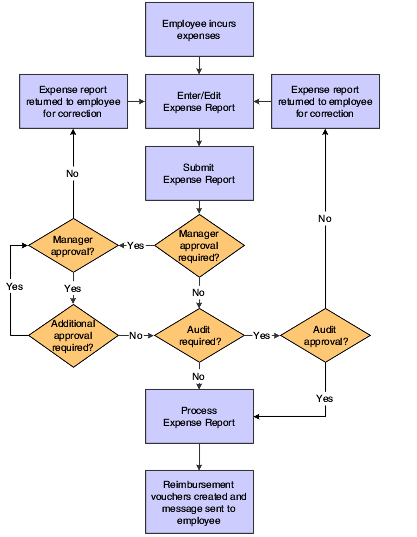2 Understanding Expense Management
This chapter contains the following topics:
2.1 Expense Management System
The JD Edwards EnterpriseOne Expense Management system (09E) is designed to help companies effectively manage reimbursement requests. The system facilitates entering expense reports and provides immediate error notification if information is missing or inaccurate. It also provides control mechanisms to monitor and audit expense reports, and the flexibility to customize the system for evolving expense and travel policies.
With JD Edwards EnterpriseOne Expense Management, you create and customize your expense reimbursement policies according to the type of expenses incurred. For each type of expense, you establish expense categories that you can customize to track pertinent information. For example, you might set up an expense category for airfare, and then further customize it to require the employee to enter a ticket number, ticket status, subledger, and so on. As you set up the expense categories in a policy, you can further define daily allowances or per diem rules, policy limits to require an audit, and rules for when a receipt is required. You can also set up expense policies to differentiate between allowable and unallowable amounts for any expense category. Unallowable amounts are amounts that exceed the daily allowance for an expense category. This portion of an expense is allocated to a separate object and subsidiary account that you set up when you map expense accounts to expense categories.
You set up group profiles and employee profiles to specify the reimbursement method and currency, as well as designate whether management approval is required for expense reports that are submitted. While you can set up this information for a group of employees, the system also allows you to override the information as needed on an individual basis. Employees can be reimbursed from the JD Edwards EnterpriseOne Accounts Payable system or the JD Edwards EnterpriseOne Payroll system, or you can directly reimburse a credit card company.
After expense reports are submitted, they might require management or auditor approval. The system provides a checklist to assist in tracking receipts received and managing expense exceptions.
If you set up the expense report process to require management approval, you can set up a system for alternate and multiple approvals. Use distribution lists and workflow to set up alternate approving managers to manage the approval process without delays if managers change or are not available. You can also set up a hierarchy of managers that are authorized to approve expense reports with larger amounts.
After the approval and audit processes are completed, the system produces accounts payable vouchers or time card records that you use to process the payment.
2.2 Expense Management Process
The Expense Management process includes these tasks:
-
To request reimbursement for work-related expenses such as business trip expenses, relocation expenses, or tuition expenses, employees must enter and submit expense reports. Each expense report consists of a header record and detail records. The header record contains the employee's address book number, the type of expense report, and other general information. The detail records contain information about each of the expenses incurred. Before submitting expense reports, employees can review report totals and verify the amounts expensed. Employees can also print reports for their records.
-
Many companies require expense reports to be approved by supervisors or managers before employees can be reimbursed. Managers can either approve or reject the reports. If a manager approves an expense report, the system changes the expense report status to indicate that it is ready for an auditor to review, if necessary, or ready for reimbursement. If the manager rejects an expense report, the system notifies the employee and the employee must revise and resubmit the report.
-
After expense reports are submitted and, if necessary, approved, they might need to be reviewed by an auditor. The auditor is responsible for verifying receipts received, and for approving reports that contain policy exceptions or reports submitted by employees who are monitored. The workflow process uses the policy audit limits and rules to determine which expense reports must be reviewed by an auditor. Auditors can either accept or reject the reports. If the auditor accepts an expense report, the system changes the expense report status to indicate that it is ready for reimbursement. If the auditor rejects an expense report, the system notifies the employee and the employee must modify and resubmit the report.
-
When the report status reaches the Reimbursement Process status, it is available for reimbursement processing. You run the Expense Report Reimbursement program (R20110) to generate the appropriate accounts payable or time card records. The system generates these records based on the reimbursement method that you specified in the employee group profile or the employee profile. After processing the expense report, the system notifies the employee.
This flowchart illustrates the Expense Management process:
Figure 2-1 Expense Management process flow

Description of "Figure 2-1 Expense Management process flow"
2.3 Expense Management Tables
The JD Edwards EnterpriseOne Expense Management system uses these tables: